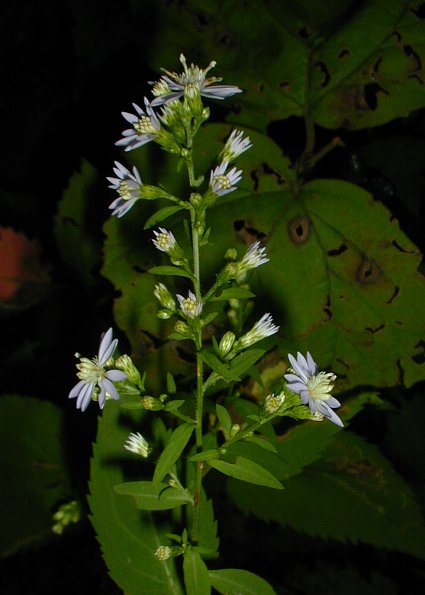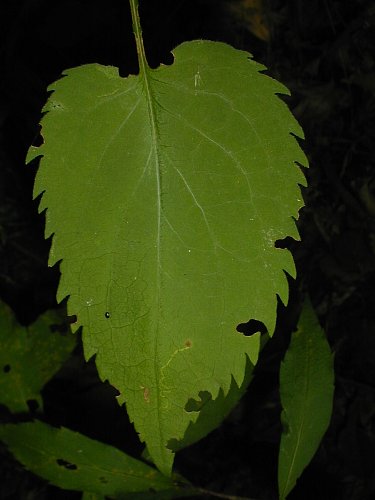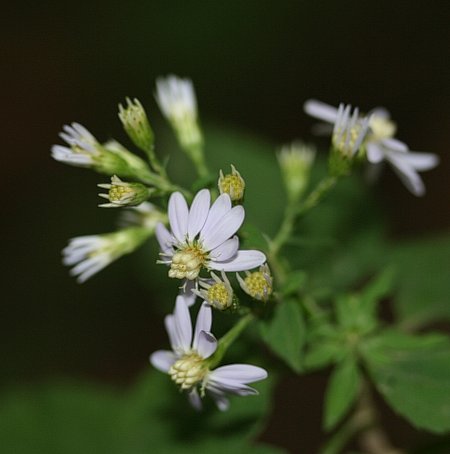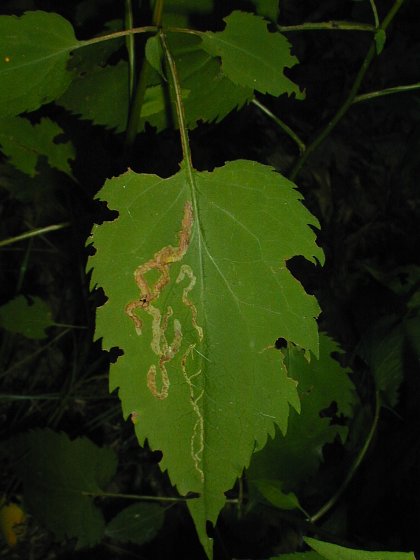Description: This perennial plant is 1-3' tall, branching occasionally in the upper half. The light green to reddish brown stems are usually glabrous; sometimes the central stem has sparse lines of hairs. The alternate leaves are up to 5" long and 3" across (excluding the petioles), becoming smaller as they ascend the stems; they are medium to dark green above and light to medium green below. The lower leaves are cordate, while the upper leaves are cordate-ovate or ovate; their margins are coarsely serrated. Leaf upper surfaces are glabrous, while their lower surfaces are either glabrous or there are hairs along the major veins. The narrow petioles of the leaves are about one-half to almost as long as their blades (up to 3½" in length); they are either unwinged or slightly winged, becoming shorter among the upper leaves. The upper stem terminates in a panicle of flowerheads about ½-1½' long. This panicle is longer than it is wide and it is more broad toward the bottom than the apex. When upper lateral stems are present, much smaller panicles may be produced. The central stalk, lateral branches, and peduncles of each panicle are light to medium green, terete, and glabrous to short-pubescent.

Each small flowerhead is about ½" across, consisting of 7-15 ray florets that surround a similar number of disk florets. The petaloid rays of these flowerheads are lavender, light blue-violet, or less often white; they are linear-oblong in shape. The corollas of the disk florets are short-tubular in shape; these corollas are initially cream-colored or pale yellow, but they later become pale purple to reddish purple with age. The apices of these corollas are 5-lobed; these lobes are short and erect. The base of each flowerhead is surrounded by slender floral bracts (phyllaries) that overlap each other in several series. These scaly bracts are light green, except for diamond-shaped patches of dark green toward their tips; they are linear-lanceolate to narrowly lanceolate in shape and about 3-5 mm. in length. The peduncles of the flowerheads are short (less than ½" in length). Among the branches of each panicle, there are leafy bracts up to 1" long; they are elliptic or linear-oblong in shape. The blooming period occurs from late summer into the fall and lasts about 1-2 months. Afterwards, the florets are replaced by achenes with small tufts of white hair. Individual achenes are 2-3 mm. long and oblongoid-oblanceoloid in shape. The root system is fibrous and short-rhizomatous. This aster reproduces by reseeding itself and vegetatively through its rhizomes.

Cultivation:
The preference is light shade or partial sun, moist to dry-mesic
conditions, and soil that contains loam, clay-loam, or some rocky
material. Occasionally the foliage is affected by powdery mildew and
other kinds of disease organisms during the fall. During hot dry
weather, the lower leaves may wilt and fall off. Plant size is variable
depending on the fertility of the soil and moisture conditions. Plants
that are grown in shade will produce smaller panicles of flowers than
those that are grown in more sunlight.
Range & Habitat:
The native Blue Wood Aster occurs occasionally in scattered counties
across Illinois (see Distribution
Map). It is more common in the northern half of the state
than in the southern half. Habitats include moist to dry deciduous
woodlands, woodland borders, areas adjacent to woodland paths, thinly
wooded bluffs, shaded areas along streambanks, and rocky wooded slopes.
Some disturbance is beneficial in heavily wooded areas if it reduces
excessive shade from overhead canopy trees or excessive
competition from shrubs.

Faunal
Associations:
The nectar and pollen of the flowerheads attract many kinds of insects,
including long-tongued bees, short-tongued bees, wasps, flies,
butterflies, skippers, and beetles. Bees are particularly important
pollinators of the flowers. Caterpillars of the butterflies Chlosyne
nycteis (Silvery Checkerspot) and Phyciodes tharos
(Pearl Crescent) feed on the foliage of asters (Symphyotrichum spp.),
as do
the caterpillars of many moth species (see Moth
Table). Some moth caterpillars also feed on the flowers,
developing seeds, stems, and roots. Other insects that feed on these
plants include leaf beetles, the larvae of leaf-mining flies and fruit
flies, plant bugs, stink bugs, lace bugs, aphids, and leafhoppers (see
the Insect Table for a
more complete listing of these species).
Mammalian herbivores, including rabbits, groundhogs, deer, and
livestock, browse on the foliage of asters occasionally. The Wild
Turkey and Ruffed Grouse eat both the foliage and seeds to some extent.
Photographic Location:
A rocky woodland in west-central Indiana. The inflorescence is small
because the photographed plant was growing in a dry upland area of a
shady woodland.

Comments: In Illinois, the Blue Wood Aster (Symphyotrichum cordifolium) often hybridizes with Arrow-Leaved Aster (Symphyotrichum sagittifolium) and Drummond's Aster (Symphyotrichum drummondii), which can make the identification of some field specimens from this aster complex very difficult. The Blue Wood Aster can be distinguished from both Arrow-Leaved Aster and Drummond's Aster by its narrow petioles; the petioles of the latter two species are conspicuously winged with narrow green margins. Unlike Drummond's Aster, the Blue Wood Aster has stems and leaf undersides that are hairless or they have lines of hair; the stems and leaf undersides of Drummond's Aster are evenly pubescent. Some authorities consider the preceding species of asters to be varieties of each other, in which case the Blue Wood Aster is the typical variety, Symphyotrichum cordifolium cordifolium. Another woodland species, Short's Aster (Symphyotrichum shortii), is also similar to Blue Wood Aster in appearance, but Short's Aster has larger flowerheads (¾–1" across) and its leaves are smooth to slightly serrated along their margins. Another common name of Symphyotrichum cordifolium is Heart-Leaved Aster. A scientific synonym of this aster is Aster cordifolius.